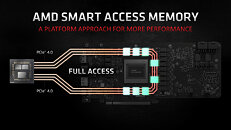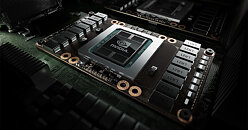Friday, November 13th 2020

NVIDIA is Working on Technology Similar to AMD's Smart Access Memory
AMD's Smart Access Memory (SAM) is a new technology that AMD decided to launch with its Ryzen 5000 series CPUs and Radeon RX 6000 series GPUs. The technology aims to solve the problem where a CPU can only access a fraction of GPU VRAM at once, making some bottlenecks in the system. By utilizing the bandwidth of PCIe, the SAM expands its data channels and uses all the speed that the PCIe connection offers. However, it appears that AMD might not be the only company offering such technology. Thanks to Gamer's Nexus, they got a reply from NVIDIA regarding a technology similar to AMD's SAM.
NVIDIA responded that: "The capability for resizable BAR is part of the PCI Express spec. NVIDIA hardware supports this functionality and will enable it on Ampere GPUs through future software updates. We have it working internally and are seeing similar performance results." And indeed, it has been a part of the PCIe specification since 2008. This document dating to 2008 says that "This optional ECN adds a capability for Functions with BARs to report various options for sizes of their memory mapped resources that will operate properly. Also added is an ability for software to program the size to configure the BAR to." Every PCIe compatible device can enable it with the driver update through the software.AMD's SAM implementation currently requires a Ryzen 5000 series CPU, 500 series motherboard chipset, and the latest Radeon RX 6000 series GPU. NVIDIA's implementation could cover a wide range of hardware, including Intel and AMD CPUs and their respective platforms. That means that even the PCIe 3.0 standard will get some love, as the current Intel desktop platforms are limited to the PCIe 3.0. NVIDIA will use a driver update to enable such a feature, however, it may take some time to arrive as the feature is still being developed.
Source:
Gamer's Nexus (Twitter)
NVIDIA responded that: "The capability for resizable BAR is part of the PCI Express spec. NVIDIA hardware supports this functionality and will enable it on Ampere GPUs through future software updates. We have it working internally and are seeing similar performance results." And indeed, it has been a part of the PCIe specification since 2008. This document dating to 2008 says that "This optional ECN adds a capability for Functions with BARs to report various options for sizes of their memory mapped resources that will operate properly. Also added is an ability for software to program the size to configure the BAR to." Every PCIe compatible device can enable it with the driver update through the software.AMD's SAM implementation currently requires a Ryzen 5000 series CPU, 500 series motherboard chipset, and the latest Radeon RX 6000 series GPU. NVIDIA's implementation could cover a wide range of hardware, including Intel and AMD CPUs and their respective platforms. That means that even the PCIe 3.0 standard will get some love, as the current Intel desktop platforms are limited to the PCIe 3.0. NVIDIA will use a driver update to enable such a feature, however, it may take some time to arrive as the feature is still being developed.


64 Comments on NVIDIA is Working on Technology Similar to AMD's Smart Access Memory
Nvidia attention seekers.
Same to how Nvidia was first with that gpu whatever check box in windows 10.
Do they really need people who just bought 3000 series to pay again for 5000? as if there isnt enough demand already…..
You want the ryzen 1000 - 2000 crowd and maybe some intel people, but you got those already purely on performance of the 5000 series....again really just dont get it.
Same with initially not allowing certain fidelity features on anything but RX5000 for no real reason, nobody with older cards is going to upgrade for that so just allow it on the established products right away….heck I would think that would give AMD hardware some extra value, that "fine whine" technology.
The very fact that your complaining about not getting an extra theoretical 2%-10% of performance with a graphics card you don't even own is ridiculous. I never like to assume intentions, but I'm having a hard time believing someone to be this unreasonable, so it comes off as just a pretext.
This isn't the first time something like this happened, with HDR AMD was the first to it, then NVIDIA "somehow" realized their GPUs supported that too but only then did they enabled it.
I refuse to go back to the era of Intel operating with impunity and giving 5% performance uplifts for high prices,... And just the glimpse we received of the RTX 2000 series price hikes should scare everyone about what would happen if AMD stops competing above midrange with GPUs. I'm not saying any of this as an AMD fan, but a self interested consumer who has greatly enjoyed the last three years and is terrified of it ceasing to exist
AMD just gave performance figures for estimated gains with a 5000 CPU and x570 - it may well work on 3000 series CPU's on x570 as well, with lesser gains... we dont know yet
They spend x time developing it and y time bugfixing/refining it on those two specific products - Ryzen 5000 and Radeon 6000.
Lots of their current revenue and even more of their future revenue to continue development and research is in those two specific products.
Now, you could say that if they spend 3y - 10y* to bugfix/refine all the dozens of permutations of older Ryzen processors and chipset combination across hundreds of BIOS and lane configurations, then that would be a goodwill gesture - but what it will not do is generate any more revenue. It might generate goodwill and PR, but AMD already have that in spades compared to the competition. Their reputation as the underdog that offers more to consumers than Nvidia or Intel for less money is pretty solid at this point.
At the end of the day, the first priority of these companies is to turn a profit, not to cater to the whims of a technically-literate minority.
* - I just pulled those numbers out of my ass for the sake of making an example. All I'm basing it on is experience that refining a concept to work in the real world usually takes much longer than getting the proof-of-concept prototyle working and that's the point I'm trying to convey there.
That is kinda what is so baffeling to me, if they were to allow on all their Ryzen cpu's….well quite a few people have those and they might then think "oh ill get a Radeon card for my next upgrade because it will go well with my cpu".
Now however if you have a 3000 ryzen, you can go either AMD or Nvidia because you dont have access to SAM anyway unless you ALSO spend money to upgrade you cpu….
That is what is so stupid about this.
Don't you just love them double standards, always good for laughs.